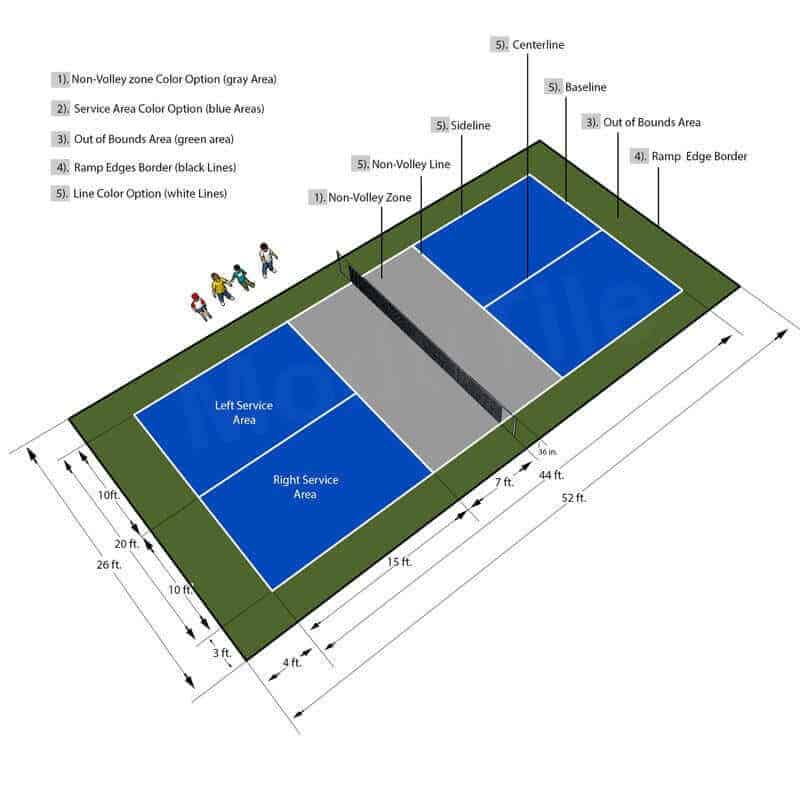Sustainable Practices in Pickleball Court Construction You Ought To Know
As the appeal of pickleball remains to increase, so too does the need for lasting techniques in court building. This method not only addresses environmental concerns but additionally improves the longevity and functionality of the courts. From selecting environmentally friendly products to applying reliable water drainage and energy-saving illumination solutions, there are numerous methods to think about. The impact of these practices extends much past the court itself. Comprehending how each element adds to a much more sustainable future invites better exploration right into the complex equilibrium in between leisure development and environmental stewardship.
Picking Eco-Friendly Materials
Selecting green materials is a critical step in the building of lasting pickleball courts. The selection of sustainable materials not only lessens ecological impact however also enhances the longevity and performance of the court. Key materials include reused rubber for the surface, which offers outstanding longevity and shock absorption while drawing away waste from garbage dumps.
Additionally, making use of in your area sourced materials lowers transportation emissions and sustains regional economic climates. Pickleball court construction. As an example, utilizing native hardwoods for fence and seats can offer a sustainable aesthetic while making sure strength versus the elements.
Integrating absorptive materials for court structures can even more add to sustainability by allowing for all-natural water drain and reducing runoff. These choices not just protect regional ecosystems however additionally promote much healthier play environments.
Efficient Drainage Solutions
While the option of eco-friendly products is essential, applying reliable water drainage solutions is equally essential for maintaining sustainable pickleball courts. Proper drainage not only secures the court surface area from water damages yet additionally minimizes erosion and runoff, promoting environmental integrity.
Efficient drain systems can consist of absorptive paving, which permits water to penetrate the ground as opposed to merging externally. This decreases the probability of standing water, which can bring about mold and mildew and other maintenance issues. In addition, including purposefully positioned drain channels and swales can route excess water far from the court area, ensuring a dry having fun surface and preventing dirt disintegration.
Using native plants in the landscaping around the courts can further boost drain by absorbing excess water and lowering overflow. These plants call for less watering and promote biodiversity, lining up with lasting practices.
Moreover, it is vital to routinely preserve the water drainage system to ensure its long-lasting performance. This includes clearing debris and surveillance for blockages. By prioritizing efficient drain solutions, pickleball court fabricators can dramatically contribute to the sustainability and longevity of the facility, ultimately benefiting both players and the environment.
Energy-Efficient Lighting Options
As the demand for pickleball continues to grow, integrating energy-efficient lights alternatives right into court design has actually ended up being significantly vital for sustainability. Conventional illumination systems usually eat too much power, adding to greater functional expenses and ecological impact. Embracing contemporary, energy-efficient technologies is important for both new constructions and renovations.
LED (Light Emitting Diode) lights stands out as a top selection as a result of its long life and energy cost savings (Pickleball court construction). Contrasted to standard lights, LEDs use approximately 75% much less energy and can last approximately 25 times longer, dramatically decreasing upkeep expenses. Furthermore, the directional nature of LED illumination reduces light air pollution, ensuring that illumination is concentrated on the court as opposed to surrounding locations.

Lasting Surface Area Alternatives
Exploring sustainable surface alternatives for pickleball courts has gotten grip amongst gamers and building contractors alike. The emphasis on environmentally friendly materials not just straightens with the expanding ecological recognition but also enhances the performance and resilience of the courts.
This material gives outstanding shock absorption, decreasing the threat of injuries for gamers while promoting sustainability. These ceramic tiles are easy to change and mount, and their adaptability allows for different court configurations.
All-natural turf courts are additionally arising as a lasting choice, promoting biodiversity and minimizing the warm island result. Nonetheless, they call for regular upkeep and water, which might not align with all sustainability see page goals.

Water Preservation Methods

An additional efficient technique involves the installment of rainwater harvesting systems. These systems collect and store rainwater for usage in maintaining court surface areas and landscape design. This method not only conserves safe and clean water yet likewise reduces dependence on municipal resources.
Furthermore, using drought-resistant landscape design around the courts is vital. Native plants require much less water and are much better adapted to neighborhood environment conditions, hence lowering general water usage. In addition, utilizing efficient irrigation systems, such as drip irrigation, makes sure that water is supplied straight to plant origins, decreasing dissipation and waste.
Verdict
Integrating sustainable methods in pickleball court building and construction considerably adds to environmental preservation and resource effectiveness. By focusing on these techniques, the construction of pickleball courts can align with wider ecological goals while promoting durability and performance within areas.
As the appeal of pickleball proceeds to climb, so too does the need for sustainable techniques in court building and construction.Choosing environment-friendly products is a crucial action in the building and construction of sustainable pickleball courts. By prioritizing energy-efficient lights alternatives, pickleball court producers can contribute to a much more sustainable future while meeting the needs of gamers and stakeholders alike.Integrating sustainable surface choices not just improves the performance of pickleball courts more but additionally paves the way for applying effective water conservation methods.Integrating sustainable techniques in pickleball court construction substantially contributes to ecological conservation and resource performance.